Delta remains bullish on foreign investments strengthening its bottom line but cost creep is a worry
Delta Air Lines in 2013 aims to narrow competitive network gaps with its US legacy rivals through the maturation of its cross-border investments in Aeromexico and Gol while laying the groundwork to strengthen its dominance in the strategic New York market. This after unveiling plans in Dec-2012 to bolster its position at London Heathrow through an equity stake in Virgin Atlantic.
As its major competitor United embarks on 2013 still in the throes of merger integration, and with a strong likelihood that American and US Airways will begin the complex process of combining their respective networks this year, Delta will continue to enjoy the revenue benefits of its long-ago completed merger with Northwest.
But Delta also has its own set of challenges to overcome including a spillover from 2012 of unit cost creep and proving to sceptics that its recently purchased oil refinery will live up to expectations. At the same time Delta's stock price continues to underperform its peers, which could mean the airline still has to convince investors that its three-year profit streak has staying power.
Delta championing its foreign equity strategy
Delta in late 2011 began executing its strategy of broadening its network through offshore investments by acquiring a 4% stake in fellow SkyTeam partner Aeromexico for USD65 million and 3% ownership in Brazil's second largest airline group Gol for USD100 million. Delta gained a seat on each carrier's board of directors and strategic access to the two largest markets in Latin America.
See related articles:
- Delta to acquire stake in Aeromexico as part of expanded alliance
- Delta's investment in Gol has SkyTeam and broader US-LatAm strategic implications
While the equity investments allow Delta to voice its opinion on the future direction of each carrier, the inherent value to Delta is bolstering its position in Mexico and Brazil relative to its peers.
Delta president Ed Bastian told attendees at Delta's annual investor day in late 2012 that the tie-up with Aeromexico has expanded Delta's network to 32 markets within Mexico. Itineraries encompassing Aeromexico's markets account for 20% of Delta's revenue generated from Mexico, while Delta's margins from 2011 to 2012 improved by 800 basis points.
Aeromexico is a valuable partner in the Mexican market
Aeromexico, combined with its subsidiary Aeromexico Connect, remains the largest carrier in the Mexican domestic market place, and since the demise of Mexicana the oneworld alliance has lacked a major partner in Mexico. The Star Alliance does not have strong presence in Mexico, but United through its merger with Continental has become the largest carrier in the US-Mexico market behind American with seats on offer.
Current schedules in Innovata (13-Jan-2013 to 19-Jan-2013) show Aeromexico is the third largest in the market, while Delta is the fifth largest with just an 8% share. Combined, Aeromexico and Delta account for approximately 22% of the US-Mexico seat share, which is equivalent to the seat share held by United. The deepened ties between Aeromexico and Delta allow for better coordination from each carrier's respective Mexican and US gateways of Mexico City and Atlanta.
Aeromexico also operates from other major US markets including Chicago, Denver, Dallas, Houston, Los Angeles, Miami, Orlando, San Francisco and Washington Dulles. The combined network with Delta allows the carriers to offer better connectivity throughout the US and Mexico, and slightly increases competition with US legacy carriers that have fortress hubs in some of Aeromexico's US markets.
Delta's revenue improvement in Mexico and Brazil: 2011 to 2012
Mexico to United States (seats per week, one way): 19-Sep-2011 to 07-Jul-2013
Gol helps Delta and SkyTeam but American still leads US airlines in a tough Brazil market
Mr Bastian stated that intra-Brazil routes operated under a codeshare with Gol account for 20% of the traffic on Delta's long-haul fights to the country. The margins on Delta's five flights from the US to Brazil grew 400 basis points during 2012. He believes once the phased-in open skies agreement between the US and Brazil takes full effect in Oct-2014, that opportunities for both Delta and Gol will increase.
Presently, Delta is limited to the five flights it operates to Gol's large bases of Rio de Janeiro and Sao Paulo. Gol has likely been a beneficiary of the feed traffic Delta supplies on its routes given the sluggish demand recorded in the Brazilian domestic market during the last couple of years. American remains the largest airline operating between the US and Brazil with respect to seats on offer, holding a 38% share. TAM's 31% share accounts for the second largest and Delta is a more distant third with a 13% share.
Brazil to United States (seats per week, one way): 19-Sep-2011 to 07-Jul-2013
Key to Delta's decision to invest in and broaden its relationship with Gol was to ensure SkyTeam had a foothold in one of Latin America's largest markets. SkyTeam has a weaker position in Latin America relative to its rival alliances oneworld and Star. Before LAN and TAM merged to become LATAM, LAN was a oneworld member while TAM joined Star in May-2010.
But in order to gain the necessary regulatory approvals, LATAM had to agree that any new carrier in the LATAM group could not be in the same alliance as Avianca-TACA, another merged Latin American powerhouse that joined Star in Jun-2012. Avianca-TACA affiliate Avianca Brazil is poised to join Star in the future after an overhaul of its IT platform, but its smaller network offers far less connectivity than TAM, which will leave Star with a weaker position in the Brazilian market.
See related articles:
- New LAN-TAM parent Latam emerges as a leader globally and a powerful force across South America
- Avianca Brazil to slow down expansion in 2013; to benefit from TAP acquisition and Star membership
While Delta's offshore investments are largely dedicated to deepening its network breadth, the timing of its investment in Gol coincided with one of the toughest financial periods for the Brazilian carrier since it commenced operations in 2001. Shortly after Delta unveiled its investment in Gol, the carrier recorded a BRL700 million (USD344 million) loss in 2011, and continued to record losses through 3Q2012.
As an equity investor, Delta no doubt is waiting for Gol management to reverse the carrier's fortunes after a promised turnaround in 2H2012 failed to materialise.
See related article: Gol attempts to improve its fortunes in 2H2012 as market conditions continue to weaken
Still, Mr Bastian stressed the foreign investment strategy Delta laid out a year ago is working, highlighting improvements in both of the carrier's business units in Latin America that are outpacing the rest of the carrier's system. However, Latin America has historically been a weaker market for Delta.
Its seat share from the US to lower South America is 10% compared with 48% for American and LAN's 18%. United's share is just shy of Delta's at roughly 9%.
United States to Latin America: Lower South America (seats per week, one way): 19-Sep-2011 to 07-Jul-2013
Virgin Atlantic investment gives Delta leverage with corporate travellers
As Delta's offshore investments in Latin America continue to mature, the carrier is also aiming to forge its joint venture with Virgin Atlantic by the end of 2013, which will allow Delta to fill a gaping hole in its network by capitalising on Virgin's stature as London Heathrow's second largest carrier.
Once the joint venture is up and running, Delta perhaps over-optimistically believes it will wipe out a major weakness in retaining lucrative business travellers. "The biggest vulnerability we have that's held us back with respect to share gains across the corporate space particularly here in New York is we don't have Heathrow frequencies," said Mr Bastian. "We don't have the scale to go against the might of the AA-BA joint venture. Now we will have that."
He stated Delta and Virgin Atlantic will have nine daily offerings between New York and Heathrow "and I think that's going to be a very powerful combination".
He stated combined Virgin and Delta will have a 25% passenger share between the US and Heathrow and a 36%-37% share in the New York-Heathrow market. Delta estimates that the corporate travel market for Heathrow is nearly three times larger than Paris Charles de Gaulle, which is the hub of Delta's SkyTeam joint venture partner Air France-KLM.
Top markets from the US to Europe and Heathrow seat share: 2012
Delta expects to generate US$120 million in annual synergies from its new tie-up with Virgin Atlantic. But similar to Gol, Delta is investing in Virgin Atlantic when it is incurring losses. For its fiscal year ending 28-Feb-2012 Virgin Atlantic recorded an operating loss of GBP80.2 million. Delta CEO Richard Anderson told investors that the USD120 million synergy estimate does not factor in any improvement in the base of Virgin Atlantic.
He admitted Delta's new partner was losing money, and explained the estimated synergies entail the long-term outlook for a three year period driven largely by revenue improvements at Delta through the expansion of its network at Heathrow. However, he did remark that Delta "certainly expects the airline [Virgin Atlantic] to be profitable within the next three years".
Given that Delta is spending USD360 million to take 49% in Virgin Atlantic, the Atlanta-based carrier will likely exert considerable influence on its latest offshore investment to ensure its new-found strength in the London Heathrow market. Mr Anderson stated that obviously with Delta's ownership stake and its position on Virgin Atlantic's board, "we will be in a position to influence the fleet plan long term". Delta's chief was responding to a query regarding Virgin Atlantic's Airbus A380 and Boeing 787 order book.
However, in many ways, Virgin's shortcomings are closer to home, where it must restore the short-haul connectivity lost when partner bmi was sold to British Airways.
Setting profitability goals at New York LaGuardia
Delta in Mar-2013 marks the first anniversary of commencing its build-up at New York LaGuardia after completing its slot swap agreement with US Airways to acquire 132 slot pairs at the airport. The carrier rolled out new route pairings in two tranches during Mar-2012 and Jul-2012.
Delta now accounts for about 46% of the departures at LaGuardia, and Mr Bastian stated that Delta's margin in the New York market (the carrier also operates from JFK) is up 2ppt despite a 45% rise in capacity during the last year.
New York LaGuardia departures: 2007 vs 2012
Delta has an internal target to achieve profitability in its LaGuardia operations in Mar-2013, and believes it is building competitive strength against rival American in the New York market. "We have historically measured our underperformance versus American Airlines, which I am very confident that we will close in 2013," said Delta EVP network planning, revenue management and marketing Glen Hauenstein.
If an American-US Airways merger does transpire, Delta could benefit from the inevitable operational woes that will ensue, and coupled with its new-found strength in Heathrow could be a viable option for frustrated corporate travellers caught in the AA-US Airways integration crossfire. United in 2012 admitted it lost some of its lucrative business passengers due to unreliable operations triggered by integration issues with Continental.
See related article: Summer operational challenges and merger challenges continue to drag down United's results
Rising unit costs as oil refinery purchase comes under scrutiny and Delta stocks under-perform
Even as Delta believes it will continue to build competitive momentum against its peers, the carrier faces its own set of challenges during 2013. Management admits that unit cost pressures the carrier experienced in 2012 will continue through the beginning of 2013.
The airline expects to record a 5%-6% rise in unit costs excluding fuel during 4Q2012, and expects the cost pressure driven by product investments and wage increases included in a new pilot contract ratified in 2012 will start to abate during 2H2013. Carrier CFO Paul Jacobson remarked that even though Delta has faced cost creep, since 2008 the carrier has maintained a cost advantage compared to its US legacy peers.
Delta's actual and projected non-fuel unit cost growth: 2007 to 2013
Delta non-fuel CASM versus its peers: 4Q2008 to 2Q2012
It is not clear if Delta's cost creep has spooked investors, but the carrier's share price remained below United and US Airways throughout most of 2012 (American entered bankruptcy protection in Nov-2011). Delta's 52-week trading range as of 15-Jan-2013 was USD8.42 to USD13.65, based on estimates from Yahoo Finance.
United's share range during the last 52 weeks has fallen between USD17.45 and USD26.11. Shares in US Airways recorded the widest range during the last year, falling between USD5.81 and USD15.60. The performance of US Airways stock was largely driven by speculation the carrier would achieve success in its efforts to merge with American.
Delta's new Trainer oil refinery will also be closely watched during 2013 after the carrier in 2012 made an unprecedented move to control its fuel expense through the acquisition of the facility located south of Philadelphia, Pennsylvania. Delta experienced a setback with the refinery's start-up during 4Q2012 due to hurricane Sandy that struck the US east coast, which will result in the carrier recording a USD50 million to USD60 million loss from the operations, instead of realising its previously stated target of a small profit. Delta has previously estimated the Trainer acquisition would result in an annual fuel cost reduction of USD300 million.
See related article: Delta's unconventional fuel hedging strategy to be put to the test as its refinery opens
Delta's contrarian strategy of investing in fuel-thirsty older aircraft will be tested over time
Delta during the last couple of years has spent less than USD1 billion in its offshore investments and the Trainer refinery, which is less than the commitments American and United have tied up in new aircraft orders.
Unlike its legacy peers Delta has decided to keep its capital expenditure on new aircraft minimal, opting instead to invest in used jets that carry lower ownership costs. The carrier has charted a different course from its US rivals by seeking foreign investments to broaden its network and taking unruly fuel expense into its own hands by integrating itself into the fuel supply chain.
The airline boasts that it has recorded a unit revenue premium versus the US industry since Apr-2011, and remains bullish that its latest moves will only extend its revenue advantage. Only time will tell if Delta's strategy is the right course for the long-term; but at the moment the carrier enjoys the advantage of looking over its shoulder at peers experiencing merger teething pains while devising strategies to remain one step in front of its US rivals.
Delta's unit revenue performance versus members of Airlines For America (A4A): Apr-2011 to Dec-2012
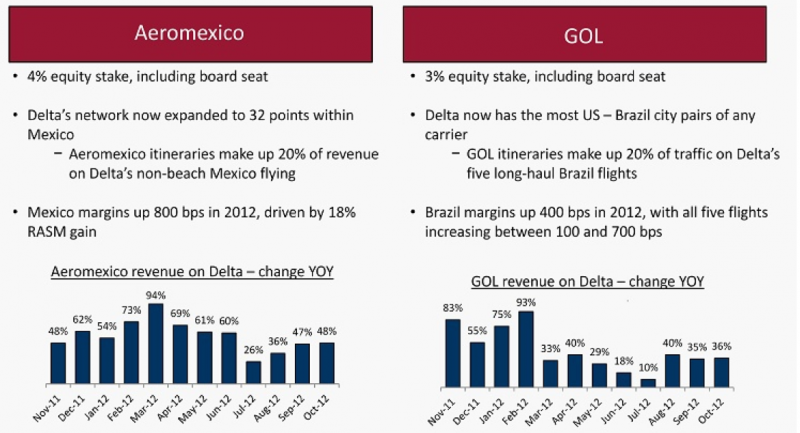
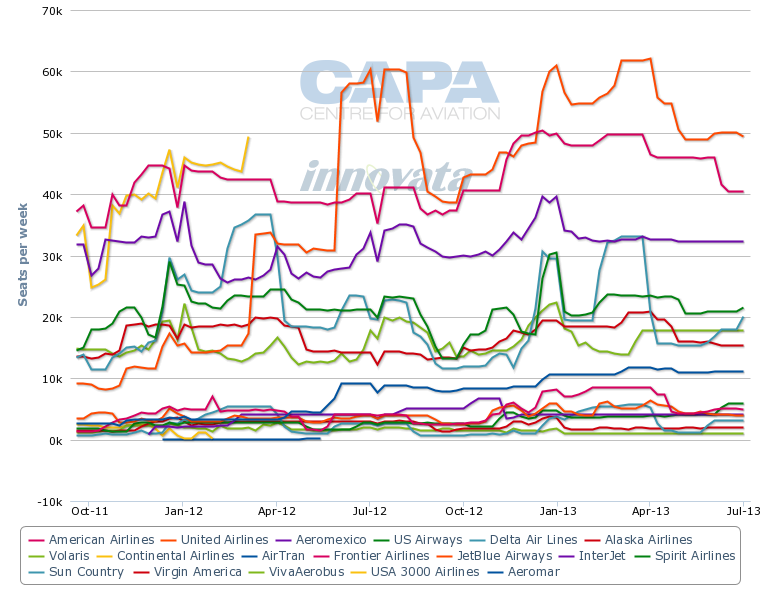
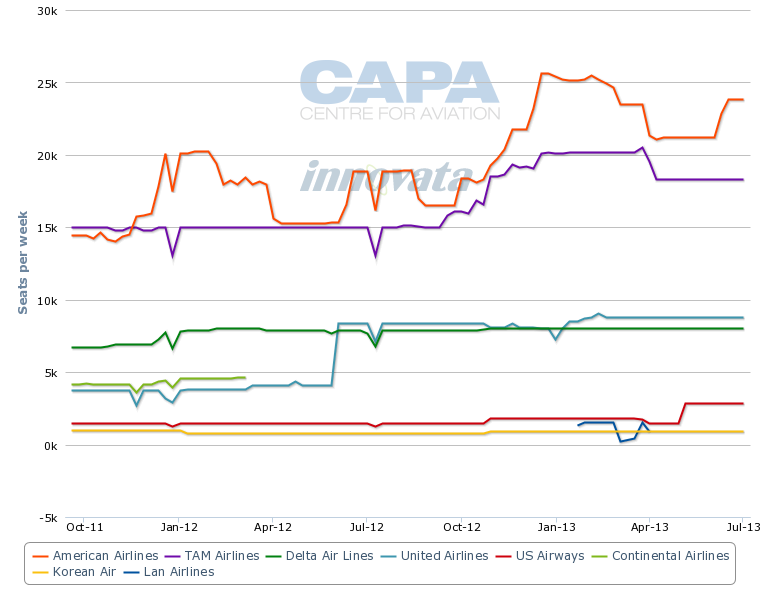
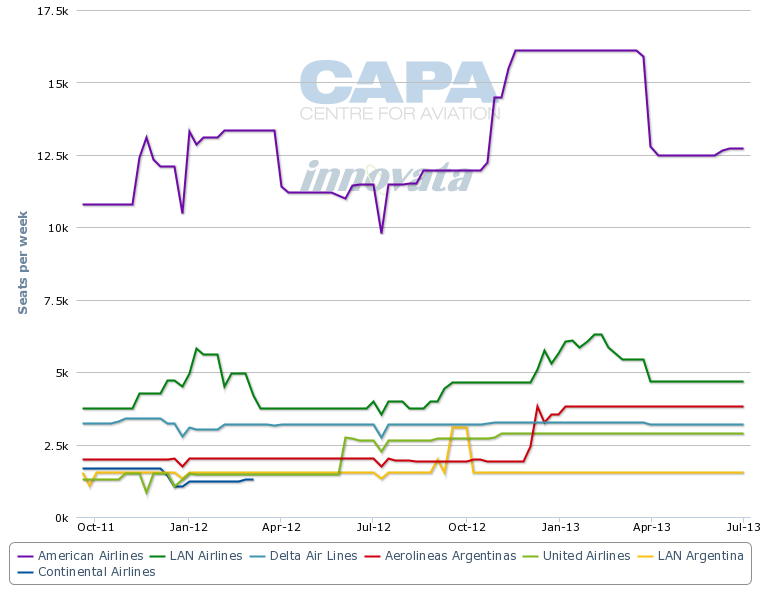

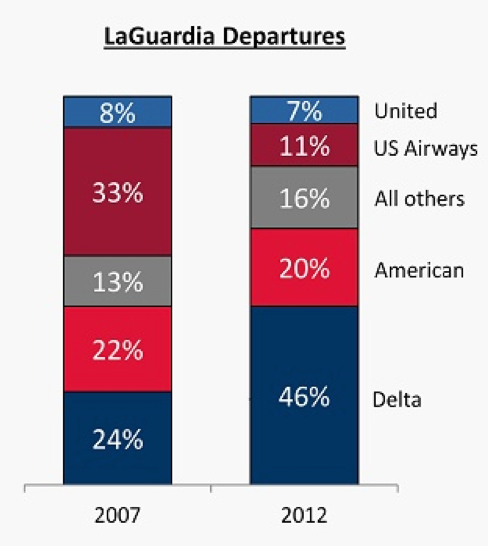
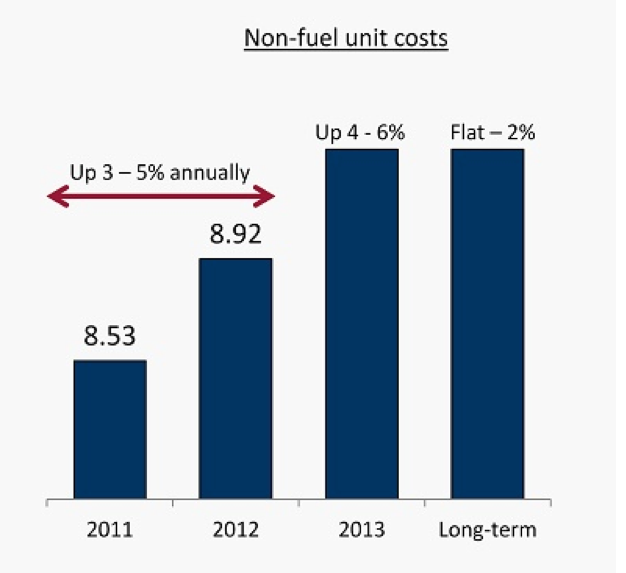
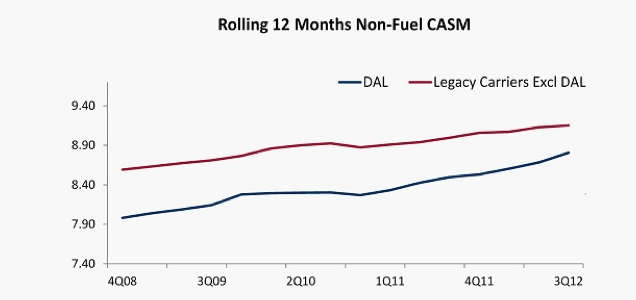
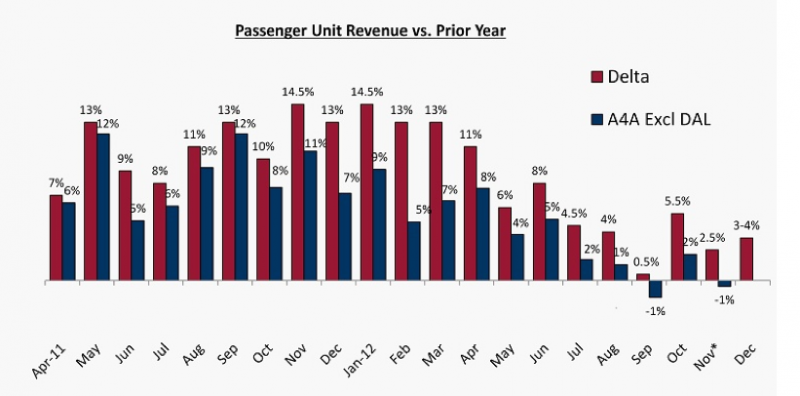 Source:
Source: